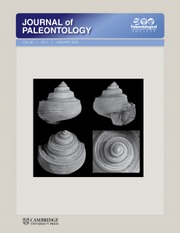It is my great honor to present Erik Sperling as the 2023 Charles Schuchert Awardee of the Paleontological Society. To be honest, if Erik didn't work in an office just down the hall from my own, I might wonder if ‘Erik Sperling’ was the pen name used by some scientific dream team including a paleontologist, a geochemist, an animal physiologist or biological oceanographer, and a sedimentary geologist. In fact, the real Erik is each of these things and, moreover, he's very good at all of them.
This extraordinary breadth is no accident. Erik has worked diligently and systematically to build his exceptional skillset. After doing a field-based Master's project on the end-Permian extinction at Stanford under the guidance of Jim Ingle, Erik set off for the East Coast, learning phylogenetics and gene regulatory networks from Kevin Peterson at Dartmouth before embarking on a Ph.D. at Yale under the tutelage of Derek Briggs, where he worked on sponge and brachiopod phylogenetics and took up an interest in the paleobiology of Ediacaran fossils. As a postdoctoral fellow at Harvard, Erik studied the iron-sulfur geochemistry of mudrocks with Dave Johnston and the environmental and biological histories of the Ediacaran and Cambrian periods with Francis Macdonald and Andy Knoll. Recognizing the need to have hands-on experience with living marine animals to fully apply a paleophysiological perspective to the fossil record, he added a stint working at Scripps with Lisa Levin, the world's expert on the biology of oxygen minimum zones.
What makes Erik exceptional is his ability to bring together insights across these disciplines to solve major problems in paleobiology. Erik is perhaps best known for his contributions to understanding the Ediacaran (or Cryogenian) origin of animals and the subsequent Cambrian and later Paleozoic radiation of animal diversity. In my view, his first game-changing contribution on that front was his 2013 paper in PNAS (Oxygen, Ecology and the Cambrian Radiation of Animals), which reconciles a long-running argument about whether the Cambrian explosion was triggered by an increase in the amount of oxygen available in seawater versus the origins of jaws and predation. In that paper, the key data came not from the fossil record but, rather, from the ecology and biogeography of animals in the oxygen minimum zone of the modern ocean. Using occurrence and ecological data from polychaetes in the modern oxygen minimum zone, Erik demonstrated that oxygen and ecology need not be viewed as competing explanations for the evolutionary paleoecology of the Cambrian. Instead, he showed us that we should see them as two shores of the same river, bridged by animal physiology. Predation is metabolically prohibitive in a low oxygen world, so that environmental changes were needed to enable the ecological revolution.
More recently, Erik has worked with graduate students in his lab on the earlier, Neoproterozoic origins of animals, arguing for a cold, deep-water cradle for early animal life. This novel hypothesis argues that the first occurrences of fossil animals in deep-marine sediments were not the result of rock or fossil preservation bias but, instead, biological signal with a physiological explanation. Building from the observation that the earliest animal fossils occur in deep-water settings, Erik and his students, especially Tom Boag, set out to test whether this observation is simply a sampling bias versus a reflection of biological reality. Through painstaking effort in a remote area of northwestern Canada, they were able to show that animal fossils do not occur in coeval shallow-marine settings, even when the taphonomic conditions were appropriate for their preservation. Combining data from physiological experiments with output from oceanographic models, with Boag and Richard Stockey, Erik then showed that deep, cold environments would be ideal for the early evolution of animals because the cold would keep metabolic rates (and associated demands for food and oxygen) low and the thermal stability of deep water would reduce the physiological stresses that come with rapid fluctuations in temperature that are more typical in shallow-marine settings.
Erik has also worked up the stratigraphic column into the Phanerozoic, with equal impact. He recognized that the principles that he was using to explain the early history of animal life could also account for the long-recognized but poorly quantified connection between anoxia and extinction in the later Phanerozoic record of marine animal life. One of Erik's most recent papers, led by his advisee Richard Stockey, makes a compelling argument from geochemistry, oceanographic models, and animal physiology that the Paleozoic decline in extinction intensity can be explained by the secular oxygenation of the oceans. This paper benefits from the massive effort that Erik put into developing the most comprehensive record of Paleozoic marine redox conditions using exceptional stratigraphic sections in remote parts of western Canada. Follow-up work has been enabled by Erik's leadership of the Sedimentary Geochemistry and Paleoenvironments Project to compile global data on marine redox conditions and to analyze those data while considering potential spatial and other sampling biases (issues long familiar to paleontologists but only emerging more recently in the consciousness of the geochemical proxy community).
There are so many more great things to say about Erik that can only be hinted at here due to length limits that I have already overstepped, especially regarding his tireless efforts as a classroom teacher, his generosity toward graduate students with his time, energy, and ideas, and his no-nonsense approach as a departmental colleague. But the most important message for the Society is that in linking the fields of paleontology, animal physiology, and geochemistry, Erik Sperling is reshaping our understanding of marine animal life, from its origins to its greatest crises, past and present. His impact promises to be broad, deep, and lasting.



